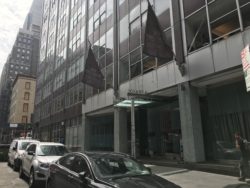
50 Murray Street in Manhattan. Image credit: CityLaw.
Tenants of a Tribeca high rise luxury rental building claimed protection of rent stabilization. Tenants of Tribeca House, a luxury rental residential building located at 50 Murray Street, Manhattan claimed that the owner of the building overcharged the tenants. Tribeca House, a twenty-one-story luxury loft apartment building, has 389 apartments comprised of studio, one, two, and three bedroom units.
The developer of Tribeca House enjoyed tax exemptions and tax abatement benefits pursuant to Real Property Tax Law section 421-g. The legislature enacted section 421-g to stimulate the conversion of nonresidential buildings in Lower Manhattan to residential use. Under section 421-g developers gained tax exemptions and abatements when a building was converted to at least 75 percent residential use. All of the rental units became subject to rent stabilization during the period that the building benefitted from the tax exemptions.
In June 2017 the tenants of Tribeca House sued for rent overcharges claiming that the rent exceeded the regulated maximum. Supreme Court Justice Carol Edmead ruled in favor of the tenants. The owner appealed.
The Appellate Division reversed and ruled in favor of the owner. The Appellate Division held that owners of buildings covered by 421-g benefited from luxury decontrol, which permits the deregulation of apartments when the rent reached a designated high level. Tribeca House apartments had been properly deregulated because virtually all of the apartments had never been regulated in the first place. Their initial high rents exceeded the deregulation threshold under luxury decontrol. The court accordingly reversed the lower court’s decision in favor of the tenants and remanded the matter for further proceedings.
Kuzmich v 50 Murray St. Acquisition LLC, 69 N.Y.S.3d 627 (1st Dep’t 2018).
By: Mary Solimine (Mary is a New York Law School Graduate, Class of 2019.)

